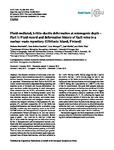Fluid-mediated, brittle–ductile deformation at seismogenic depth – Part 1: Fluid record and deformation history of fault veins in a nuclear waste repository (Olkiluoto Island, Finland)
| dc.contributor.author | Marchesini, B | en |
| dc.contributor.author | Garofalo, PS | en |
| dc.contributor.author | Menegon, L | en |
| dc.contributor.author | Mattila, J | en |
| dc.contributor.author | Viola, G | en |
| dc.date.accessioned | 2019-10-27T16:30:01Z | |
| dc.date.accessioned | 2019-10-27T16:31:52Z | |
| dc.date.available | 2019-10-27T16:30:01Z | |
| dc.date.available | 2019-10-27T16:31:52Z | |
| dc.date.issued | 2019-06-13 | en |
| dc.identifier.issn | 1869-9510 | en |
| dc.identifier.uri | http://hdl.handle.net/10026.1/15068 | |
| dc.description.abstract |
<jats:p><p><strong>Abstract.</strong> The dynamic evolution of fault zones at the seismogenic brittle–ductile transition zone (BDTZ) expresses the delicate interplay between numerous physical and chemical processes. Deformation and fluid flow at the BDTZ are closely related and mutually dependent during repeating and transient cycles of frictional and viscous deformation. Despite numerous studies documenting in detail seismogenic faults exhumed from the BDTZ, uncertainties remain as to the exact role of fluids in facilitating broadly coeval brittle and ductile deformation at that structural level. We combine structural analysis, fluid inclusion, and mineral chemistry data from synkinematic and authigenic minerals to reconstruct the temporal variations in fluid pressure (<span class="inline-formula"><i>P</i><sub>f</sub></span>), temperature (<span class="inline-formula"><i>T</i></span>), and bulk composition (<span class="inline-formula"><i>X</i></span>) of the fluids that mediated deformation and steered strain localization along BFZ300, a strike–slip fault originally active at the BDTZ. BFZ300 deforms the Paleoproterozoic migmatitic basement of southwestern Finland and hosts in its core two laterally continuous quartz veins formed by two texturally distinct types of quartz – Qtz I and Qtz II, with Qtz I older than Qtz II. Veins within the damage zone are formed exclusively by Qtz I. Mesostructural and microstructural analysis combined with fluid compositional data indicate recurrent cycles of mutually overprinting brittle and ductile deformation triggered by oscillations of fluid pressure peaking at 210&amp;thinsp;MPa. Fluid inclusion microthermometry and mineral pair geothermometry indicate that the two documented quartz types precipitated from different fluid batches, with bulk salinities in the 1&amp;thinsp;wt&amp;thinsp;% NaCleq–5&amp;thinsp;wt&amp;thinsp;% NaCleq range for Qtz I and in the 6&amp;thinsp;wt&amp;thinsp;% NaCleq–11&amp;thinsp;wt&amp;thinsp;% NaCleq range for Qtz II. The temperature of the fluids involved with initial strain localization and later fault reactivation evolved through time from &amp;gt;&amp;thinsp;350&amp;thinsp;<span class="inline-formula"><sup>∘</sup></span>C during Qtz I precipitation to &amp;lt;&amp;thinsp;300&amp;thinsp;<span class="inline-formula"><sup>∘</sup></span>C at the time of Qtz II crystallization. The peak fluid pressure estimates constrain pore pressure oscillations between 80 and 210&amp;thinsp;MPa during the recorded faulting episodes. Our results suggest variability of the physico-chemical conditions of the fluids steering deformation (<span class="inline-formula"><i>P</i><sub>f</sub></span>, <span class="inline-formula"><i>T</i></span>, <span class="inline-formula"><i>X</i></span>), reflecting the ingress and effects of multiple batches of fluid in the fault zone. Initial fluid-mediated embrittlement generated a diffuse network of joints and/or hybrid–shear fractures in the damage zone; subsequent strain localization led to more localized deformation within the fault core. Localization was guided by cyclically increasing fluid pressure and transient embrittlement of a system that was otherwise under overall ductile conditions.</p> <p>Our analysis suggests that fluid overpressure at the BDTZ can play a key role in the initial embrittlement of the deforming rock and steer subsequent strain localization.</p> </jats:p> | en |
| dc.format.extent | 809 - 838 | en |
| dc.language | en | en |
| dc.language.iso | en | en |
| dc.publisher | European Geosciences Union | en |
| dc.relation.replaces | http://hdl.handle.net/10026.1/15067 | |
| dc.relation.replaces | 10026.1/15067 | |
| dc.title | Fluid-mediated, brittle–ductile deformation at seismogenic depth – Part 1: Fluid record and deformation history of fault veins in a nuclear waste repository (Olkiluoto Island, Finland) | en |
| dc.type | Journal Article | |
| plymouth.issue | 3 | en |
| plymouth.volume | 10 | en |
| plymouth.journal | Solid Earth | en |
| dc.identifier.doi | 10.5194/se-10-809-2019 | en |
| plymouth.organisational-group | /Plymouth | |
| plymouth.organisational-group | /Plymouth/Faculty of Science and Engineering | |
| plymouth.organisational-group | /Plymouth/REF 2021 Researchers by UoA | |
| plymouth.organisational-group | /Plymouth/REF 2021 Researchers by UoA/UoA07 Earth Systems and Environmental Sciences | |
| dcterms.dateAccepted | 2019-05-14 | en |
| dc.rights.embargodate | 2019-12-18 | en |
| dc.identifier.eissn | 1869-9529 | en |
| dc.rights.embargoperiod | Not known | en |
| rioxxterms.versionofrecord | 10.5194/se-10-809-2019 | en |
| rioxxterms.licenseref.uri | http://www.rioxx.net/licenses/all-rights-reserved | en |
| rioxxterms.licenseref.startdate | 2019-06-13 | en |
| rioxxterms.type | Journal Article/Review | en |


